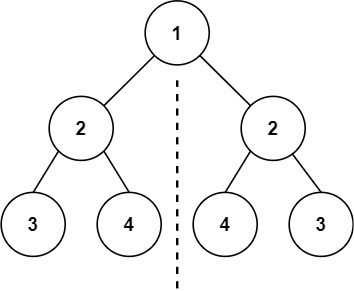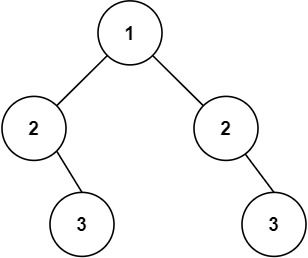Given the root of a binary tree, check whether it is a mirror of itself (i.e., symmetric around its center).
Example 1:
Input: root = [1,2,2,3,4,4,3] Output: true
Example 2:
Input: root = [1,2,2,null,3,null,3] Output: false
Constraints:
- The number of nodes in the tree is in the range
[1, 1000]. -100 <= Node.val <= 100
Follow up: Could you solve it both recursively and iteratively?
# Definition for a binary tree node.
# class TreeNode:
# def __init__(self, x):
# self.val = x
# self.left = None
# self.right = None
class Solution:
def isSymmetric(self, root: TreeNode) -> bool:
if root is None:
return True
return self.is_symmetric(root.left, root.right)
def is_symmetric(self, left: TreeNode, right: TreeNode) -> bool:
if left is None and right is None:
return True
if left is None or right is None or left.val != right.val:
return False
return self.is_symmetric(left.left, right.right) and self.is_symmetric(left.right, right.left)/**
* Definition for a binary tree node.
* public class TreeNode {
* int val;
* TreeNode left;
* TreeNode right;
* TreeNode(int x) { val = x; }
* }
*/
class Solution {
public boolean isSymmetric(TreeNode root) {
if (root == null) return true;
return isSymmetric(root.left, root.right);
}
private boolean isSymmetric(TreeNode left, TreeNode right) {
if (left == null && right == null) return true;
if (left == null || right == null || left.val != right.val) return false;
return isSymmetric(left.left, right.right) && isSymmetric(left.right, right.left);
}
}class Solution {
public:
bool isSymmetric(TreeNode* root) {
if (!root) return true;
return isSymmetric(root->left, root->right);
}
private:
bool isSymmetric(TreeNode* left, TreeNode* right) {
if (!left && !right) return true;
if (!left && right || left && !right || left->val != right->val) return false;
return isSymmetric(left->left, right->right) && isSymmetric(left->right, right->left);
}
};

